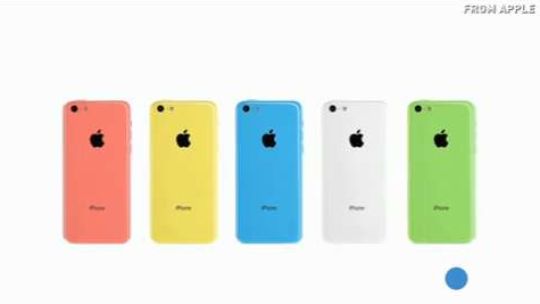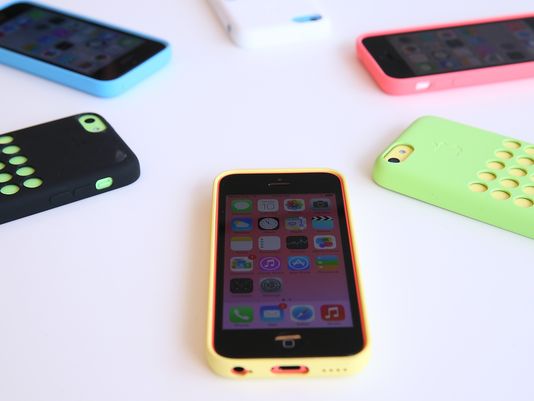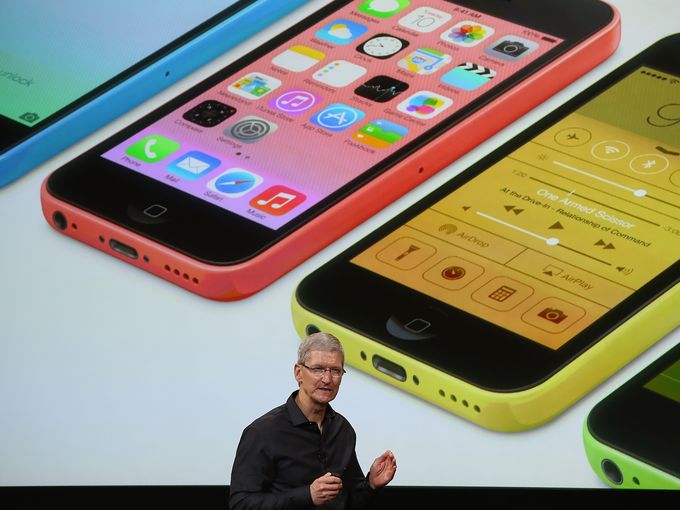Apple alters course to challenge Google's Android
CUPERTINO, Calif. — Apple tiptoed down market on Tuesday, unveiling a cheaper, colorful iPhone as the technology giant tries to regain lost market share from Android, the rival mobile platform run by Silicon Valley neighbor Google.
Apple announced two new iPhones for the first time — a high-end iPhone 5s starting at $199 and the iPhone 5c, which starts at $99 with a two-year contract.
BAIG: Are fresh colors, fingerprint tech enough?[1]
"This allows us to serve even more customers," Apple CEO Tim Cook said during a launch event at company headquarters.
The move marks one of the most important strategy shifts by Apple since Cook took over from legendary leader Steve Jobs, who passed away in 2011, analysts said after the event.
"They have saturated the high end of the smartphone market and are going lower to get a wider audience," said Brian Marshall, an analyst at ISI Group. "There's a lot of competition out there."

Apple shares fell 2.3% to $494.64 on Tuesday, partly on concern that the 5c may not be cheap enough.
Since Apple set the smartphone market on fire with the introduction of the iPhone in 2007, the company has stuck to a premium-pricing strategy, betting that cutting-edge technology would persuade consumers to pay up for the devices. But after a few years of torrid growth, cheaper phones made by Samsung, Lenovo and other Asian manufacturers — mostly running on Android software — began grabbing market share.
Apple is expected to see its share of U.S. smartphone users reach 38.3% this year, but Android's share will hit almost 45.9%, eMarketer estimates. In China, the most important new smartphone market, Apple recently ranked seventh in market share, behind mostly Android phone makers such as Samsung, Lenovo and Xiaomi, according to estimates by research firm Canalys.
The iPhone 5c shows that Apple is softening its stance on pricing in the hope of reviving its market share. The question is whether the change in strategy has come too late — and whether the company can keep its juicy profit margins.
Earlier this year, Morgan Stanley analyst Katy Huberty estimated that Apple could generate $2.4 billion in extra revenue and triple its customer numbers in China if it came out with a cheaper iPhone.
But making a cheaper iPhone could dent Apple's margins, partly by eating into sales of its top-of-the-line smartphone. This has happened in the past with other formerly successful mobile handset companies, according to Jason Jones of hedge fund firm HighStep Capital.
However, Apple may avoid this fate because it has waited several years to offer a cheaper iPhone, and in that time the cost of components has dropped a lot, Jones argued.
"Apple is taking baby steps towards growth, with profit margins in mind," said Forrester analyst Sarah Rotman Epps.
The iPhone 5c is Apple's effort to reach midrange customers who can't afford the most-expensive smartphone but want to pay extra to get a good device, she added.
But the 5c costs $549 out of contract, which still puts the phone out of reach for a lot of consumers outside the U.S., she noted.
"To reach the maximum number of customers, ideally you would have a product that millions more consumers could afford un-subsidized," Epps added. "Android appeals to the greatest number of consumers because the operating system is free, which allows hardware makers to sell their phones cheaper."
The iPhone 5s will sell briskly because new technology, such as fingerprint authentication, gives Apple fans enough of a reason to upgrade from previous models, Epps said.

The iPhone 5c will be a tougher sell because Apple is going after a new customer who is also considering Android, she added.
Apple is taking this risk because the company wants growth but also needs to maintain its profit margins.
"Shareholders want it all — growth and high profit margins — and Apple is walking a tightrope between those two goals," Epps said.
Indeed, an appropriately priced iPhone is not enough by itself to expand distribution — the company will need help from new wireless carriers, especially outside the U.S.
Apple announced a deal on Tuesday with NTT Docomo, a Japanese wireless carrier with more than 60 million subscribers, and later this year the company is expected to sign up China Mobile, the world's largest carrier, which has more than 740 million subscribers.
While Apple's main announcements came from its headquarters in California, the company also held satellite events in Beijing and Tokyo.
"The launch of the new devices in China, at the same time as Apple's usual launch countries is highly significant," said Chris Jones of Canalys. "Thirty-seven percent of all smartphones shipped globally in the second quarter were in China, and China has represented approximately 16% of Apple's global iPhone shipments this year."
If Apple can add 100 new carriers in 2014, the company could sell an extra 31.5 million iPhones — and every 5 million iPhones sold produce another $1.04 of earnings per share, Wells Fargo analyst Maynard Um estimated recently in a note to investors.
References
- ^ http://www.usatoday.com/story/tech/columnist/baig/2013/09/10/apple-iphone-ios7-first-impressions/2793065/ (www.usatoday.com)
- ^ Last Slide (rssfeeds.usatoday.com)
- ^ Next Slide (rssfeeds.usatoday.com)





































